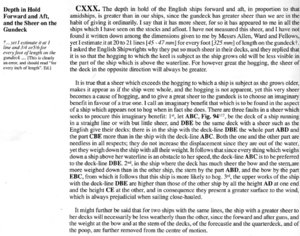In 17th century Great Ships like HMS Sovereign of the Seas, Wasa, and La Couronne, why is the sheer of the interior decks so great? Wouldn't the cannons and furniture be at strange and awkward angles at extreme ends of the ship?
-
LUCZORAMA SHIPWRECK SCAVENGER HUNT GIVEAWAY. 4 Weeks of Fun • 1 Legendary Prize ((OcCre’s Fram Ship)) • Global Crew Welcome!
**VIEW THREAD HERE**
You are using an out of date browser. It may not display this or other websites correctly.
You should upgrade or use an alternative browser.
You should upgrade or use an alternative browser.
Basic question about deck sheer
- Thread starter DARIVS ARCHITECTVS
- Start date
- Watchers 4
Anyone ?
Maybe we missed this question and post,I will keep it hotAnyone ?
- Joined
- Dec 1, 2016
- Messages
- 5,960
- Points
- 728

looking down the deck of the WASA you can see the overall sheer of the deck, But I think it is small enough over the full length of the ship that you would not notice it where you are standing or sitting
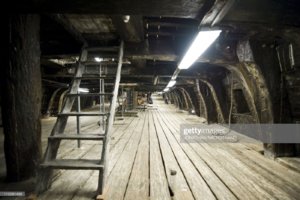
the image is from the Wasa museum which allows usage for non commercial web sites and forums
SOS is a non commercial site we do not sell ad space or products.
I checked with the museum and here is their statement
Common uses include:
 papers and magazines (except for covers), editorial broadcasts, documentaries, non-commercial websites, blogs and social media posts illustrating matters of public interest
papers and magazines (except for covers), editorial broadcasts, documentaries, non-commercial websites, blogs and social media posts illustrating matters of public interest
credit is given to the photographer

the image is from the Wasa museum which allows usage for non commercial web sites and forums
SOS is a non commercial site we do not sell ad space or products.
I checked with the museum and here is their statement
Common uses include:
 papers and magazines (except for covers), editorial broadcasts, documentaries, non-commercial websites, blogs and social media posts illustrating matters of public interest
papers and magazines (except for covers), editorial broadcasts, documentaries, non-commercial websites, blogs and social media posts illustrating matters of public interestcredit is given to the photographer
Last edited:
looking down the deck of the WASA you can see the overall sheer of the deck, But I think it is small enough over the full length of the ship that you would not notice it where you are standing or sitting
I have seen this and other photos of Wasa on the museum site, and it makes me believe that the extreme sheer shown in art depictions of ships is exhaggerated. Can you tell me what the purpose of the sheer is with regard to ship handling?
- Joined
- Dec 1, 2016
- Messages
- 5,960
- Points
- 728

The sheer is a measure of longitudinal main deck curvature, in naval architecture. The sheer forward is usually twice that of sheer aft. Increases in the rise of the sheer forward and aft build volume into the hull, and in turn increase its buoyancy forward and aft, thereby keeping the ends from diving into an oncoming wave and slowing the ship. In the early days of sail, one discussed a hull's sheer in terms of how much "Hang" it had.
A ships hull will "hog" that is droop at the bow and stern sheer to the deck adds more space in the hull at the ends thus better buoyancy to help prevent the hull from sagging.
William Sutherland's The Ship-builders Assistant
A ships hull will "hog" that is droop at the bow and stern sheer to the deck adds more space in the hull at the ends thus better buoyancy to help prevent the hull from sagging.
William Sutherland's The Ship-builders Assistant
Thanks Dave! I'm a marine engineer by the way, with years of experience sailing modern cargo ships, so the terminology isn't lost on me. Steel ships just aren't built the way wooden ones are. Thanks for explaining the sheer's effect on bow/stern buoyancy. It makes sense if you think about how the hull could plunge into the trough and be slowed. If I could only show you how much bending I've seen in a supertanker I once sailed, you'd be astounded at how much racking, hogging and sagging bent the hull. Quite flexible.The sheer is a measure of longitudinal main deck curvature, in naval architecture. The sheer forward is usually twice that of sheer aft. Increases in the rise of the sheer forward and aft build volume into the hull, and in turn increase its buoyancy forward and aft, thereby keeping the ends from diving into an oncoming wave and slowing the ship. In the early days of sail, one discussed a hull's sheer in terms of how much "Hang" it had.
A ships hull will "hog" that is droop at the bow and stern sheer to the deck adds more space in the hull at the ends thus better buoyancy to help prevent the hull from sagging.
William Sutherland's The Ship-builders Assistant
- Joined
- Dec 1, 2016
- Messages
- 5,960
- Points
- 728

What appears to be saying is that the weight of the forecastle, being higher in a ship with great sheer, would place more weight above the metacenter "M". This could cause the GM to be shorter at large angles of heel, lessening the tendency for the ship to right itself when rocked to one side. That is, as we say, BAD. However, if the ship were in deep waves, the greater sheer might cause the ship to be more buoyant at the bow (or stern) when in the trough of a wave, when sagging forces are maximized, and when the bow would tend to plunge deep into the water as it move forward. More sheer may reduce the plunge and thus make the ship more seaworthy in rough weather. There probably is a careful balance between these two properties to achieve a balance between stability and weatherliness in deep waves.
Last edited:
There are a number of factors to consider here:
First the way a ship is planked, and the rubbing wales. They follow a line from stem to stern that has more curvature than the decks. That is part of how the ships are built in those days.
In addition, the cap rails are more elegant if they don't have 2m steps at each break. In the XVII century, the decoration was still a very important part of prestige for a navy. That has led to excess sometimes.
Having seen the Wasa and been on board Batavia in Holland, I concur with what was written above. The slant of the decks inside is not that bad.
Consider the lines I have drawn on this Van de Velde period drawing.
You will also see that the last few guns on the second battery deck are not in line with the rest, implying that there would have been a step in that deck aft.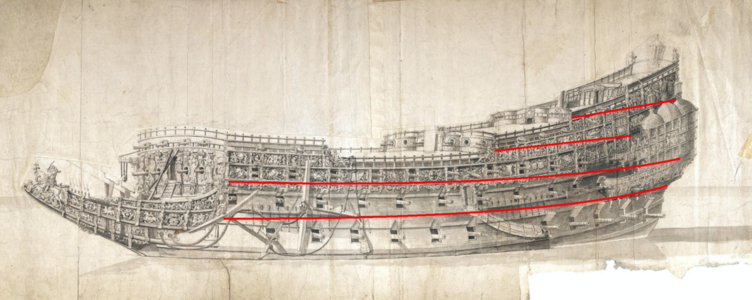
One might imagine that, for the sake of decoration, the galleries have received the same sheer as the cap rails, which would give a very strange aspect to the windows seen from the inside.
There is a plan of a Mantua model that actually positions the galleries in a much more realistic angle, but that contradicts most historical sources.
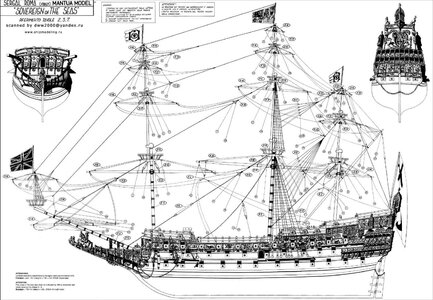
On the other hand, there is a source on the net where it is said that the decks have been re-aligned at the 1660 rebuild.
That site, sadly, does not quote sources.
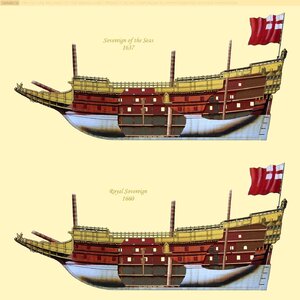
Finally, even Van de Velde did not get it right every time. In views of a ship from behind, perspective tends to imply that the lower battery deck sags at the stern. A character that is even exaggerated in some of Jan de Quelery's work.
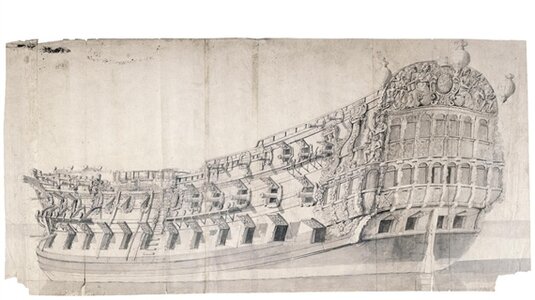
At any rate, when in doubt about deck sheer, follow the guns.
First the way a ship is planked, and the rubbing wales. They follow a line from stem to stern that has more curvature than the decks. That is part of how the ships are built in those days.
In addition, the cap rails are more elegant if they don't have 2m steps at each break. In the XVII century, the decoration was still a very important part of prestige for a navy. That has led to excess sometimes.
Having seen the Wasa and been on board Batavia in Holland, I concur with what was written above. The slant of the decks inside is not that bad.
Consider the lines I have drawn on this Van de Velde period drawing.
You will also see that the last few guns on the second battery deck are not in line with the rest, implying that there would have been a step in that deck aft.

One might imagine that, for the sake of decoration, the galleries have received the same sheer as the cap rails, which would give a very strange aspect to the windows seen from the inside.
There is a plan of a Mantua model that actually positions the galleries in a much more realistic angle, but that contradicts most historical sources.

On the other hand, there is a source on the net where it is said that the decks have been re-aligned at the 1660 rebuild.
That site, sadly, does not quote sources.

Finally, even Van de Velde did not get it right every time. In views of a ship from behind, perspective tends to imply that the lower battery deck sags at the stern. A character that is even exaggerated in some of Jan de Quelery's work.

At any rate, when in doubt about deck sheer, follow the guns.

